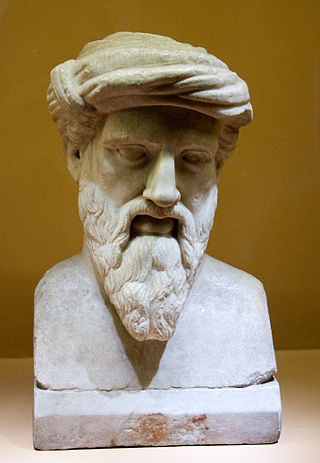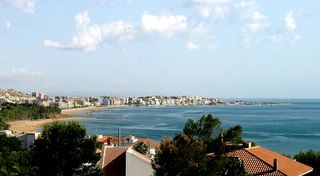
Pythagoras of Samos was an ancient Ionian Greek philosopher, polymath and the eponymous founder of Pythagoreanism. His political and religious teachings were well known in Magna Graecia and influenced the philosophies of Plato, Aristotle, and, through them, the West in general. Knowledge of his life is clouded by legend, but he appears to have been the son of Mnesarchus, a gem-engraver on the island of Samos or the city of Tyre. Modern scholars disagree regarding Pythagoras's education and influences, but they do agree that, around 530 BC, he travelled to Croton in southern Italy, where he founded a school in which initiates were sworn to secrecy and lived a communal, ascetic lifestyle. This lifestyle entailed a number of dietary prohibitions, traditionally said to have included vegetarianism, although modern scholars doubt that he ever advocated complete vegetarianism; he was said to have advised athletes to "feast on flesh" exclusively.


Pythagoreanism originated in the 6th century BC, based on and around the teachings and beliefs held by Pythagoras and his followers, the Pythagoreans. Pythagoras established the first Pythagorean community in the ancient Greek colony of Kroton, in modern Calabria (Italy). Early Pythagorean communities spread throughout Magna Graecia.
Apollonius is a masculine given name which may refer to:

Hippasus of Metapontum was a Greek philosopher and early follower of Pythagoras. Little is known about his life or his beliefs, but he is sometimes credited with the discovery of the existence of irrational numbers. The discovery of irrational numbers is said to have been shocking to the Pythagoreans, and Hippasus is supposed to have drowned at sea, apparently as a punishment from the gods for divulging this and crediting it to himself instead of pythagoras which was the norm in pythagorean society. However, the few ancient sources which describe this story either do not mention Hippasus by name or alternatively tell that Hippasus drowned because he revealed how to construct a dodecahedron inside a sphere. The discovery of irrationality is not specifically ascribed to Hippasus by any ancient writer.
Theano was a 6th-century BC Pythagorean philosopher. She has been called the wife or student of Pythagoras, although others see her as the wife of Brontinus. Her place of birth and the identity of her father is uncertain as well. Many Pythagorean writings were attributed to her in antiquity, including some letters and a few fragments from philosophical treatises, although these are all regarded as spurious by modern scholars.

Orphism is the name given to a set of religious beliefs and practices originating in the ancient Greek and Hellenistic world, associated with literature ascribed to the mythical poet Orpheus, who descended into the Greek underworld and returned. This type of journey is called a katabasis and is the basis of several hero worships and journeys. Orphics revered Dionysus and Persephone. Orphism has been described as a reform of the earlier Dionysian religion, involving a re-interpretation or re-reading of the myth of Dionysus and a re-ordering of Hesiod's Theogony, based in part on pre-Socratic philosophy.
Timaeus is a Greek name. It may refer to:
Timaeus of Locri is a character in two of Plato's dialogues, Timaeus and Critias. In both, he appears as a philosopher of the Pythagorean school. If there ever existed a historical Timaeus of Locri, he would have lived in the fifth century BC, but his historicity is dubious since he only appears as a literary figure in Plato's works; all other ancient sources are either based on Plato or are fictional accounts.

The Pythagoras tree is a plane fractal constructed from squares. Invented by the Dutch mathematics teacher Albert E. Bosman in 1942, it is named after the ancient Greek mathematician Pythagoras because each triple of touching squares encloses a right triangle, in a configuration traditionally used to depict the Pythagorean theorem. If the largest square has a size of L × L, the entire Pythagoras tree fits snugly inside a box of size 6L × 4L. The finer details of the tree resemble the Lévy C curve.

Samos is a Greek island in the eastern Aegean Sea, south of Chios, north of Patmos and the Dodecanese, and off the coast of western Turkey, from which it is separated by the 1.6-kilometre (1.0 mi)-wide Mycale Strait. It is also a separate regional unit of the North Aegean region.
Education for Greek people was vastly "democratized" in the 5th century B.C., influenced by the Sophists, Plato, and Isocrates. Later, in the Hellenistic period of Ancient Greece, education in a gymnasium school was considered essential for participation in Greek culture. The value of physical education to the ancient Greeks and Romans has been historically unique. There were two forms of education in ancient Greece: formal and informal. Formal education was attained through attendance to a public school or was provided by a hired tutor. Informal education was provided by an unpaid teacher and occurred in a non-public setting. Education was an essential component of a person's identity.
Pythagoras of Samos or Pythagoras of Rhegion was an Ancient Greek sculptor from Samos. Pliny the Elder describes two different sculptors who bore a remarkable personal likeness to each other. In the nineteenth century Dictionary of Greek and Roman Biography and Mythology, Philip Smith accepted the opinion of Karl Julius Sillig (1801–1855) that Pliny's date of Olympiad 87 ought to be referred to a Pythagoras of Samos but not a Pythagoras of Rhegium; other writers considered it possible Pythagoras of Samos lived closer to the beginning of the 5th century BC. Modern writers consider it certain these two were the same artist, and that this Pythagoras was one of the Samian exiles who moved to Zankle at the beginning of the 5th century BC and came under the power of the tyrant Anaxilas in Rhegium. While a Samian by birth, he was a pupil of Clearchus of Rhegium.
Myia was a Pythagorean philosopher and, according to later tradition, one of the daughters of Theano and Pythagoras.
Pythagoras tree may refer to:
Pythagoras of Samos lived in the period around the last part of 6th century BC and early 5th century BC, and was an ancient Greek boxer and a winner in boxing at the ancient Olympic Games.

An astronomical system positing that the Earth, Moon, Sun, and planets revolve around an unseen "Central Fire" was developed in the fifth century BC and has been attributed to the Pythagorean philosopher Philolaus. The system has been called "the first coherent system in which celestial bodies move in circles", anticipating Copernicus in moving "the earth from the center of the cosmos [and] making it a planet". Although its concepts of a Central Fire distinct from the Sun, and a nonexistent "Counter-Earth" were erroneous, the system contained the insight that "the apparent motion of the heavenly bodies" was due to "the real motion of the observer". How much of the system was intended to explain observed phenomena and how much was based on myth, mysticism, and religion is disputed. While the departure from traditional reasoning is impressive, other than the inclusion of the five visible planets, very little of the Pythagorean system is based on genuine observation. In retrospect, Philolaus's views are "less like scientific astronomy than like symbolical speculation."

The Italian School of Pre-Socratic philosophy refers to Ancient Greek philosophers in Italy or Magna Graecia in the 6th and 5th century BC. The doxographer Diogenes Laërtius divides pre Socratic philosophy into the Ionian and Italian School. According to classicist Jonathan Barnes, "Although the Italian 'school' was founded by émigrés from Ionia, it quickly took on a character of its own." According to classicist W. K. C. Guthrie, it contrasted with the "materialistic and purely rational Milesians."








